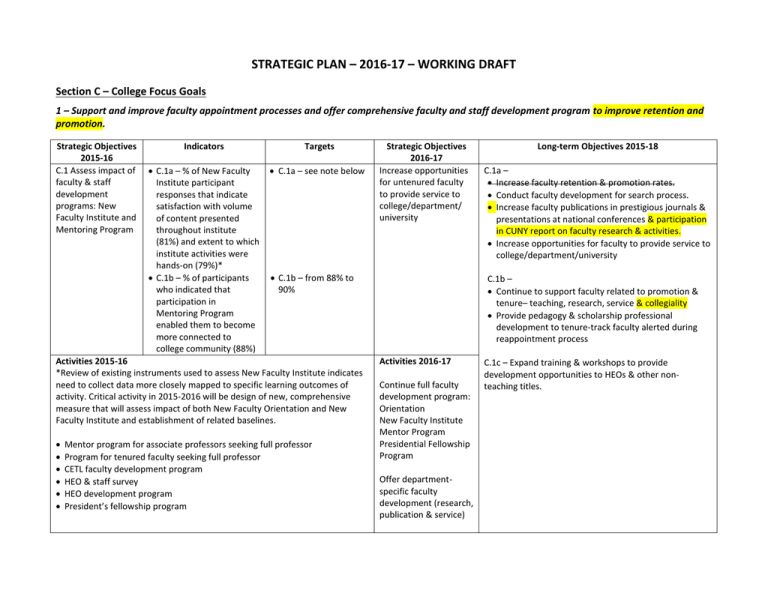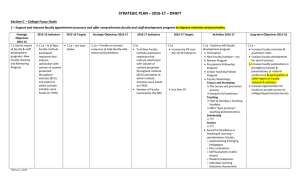STRATEGIC PLAN – 2016-17 – WORKING DRAFT
advertisement

STRATEGIC PLAN – 2016-17 – WORKING DRAFT Section C – College Focus Goals 1 – Support and improve faculty appointment processes and offer comprehensive faculty and staff development program to improve retention and promotion. Strategic Objectives 2015-16 C.1 Assess impact of faculty & staff development programs: New Faculty Institute and Mentoring Program Indicators Targets C.1a – % of New Faculty Institute participant responses that indicate satisfaction with volume of content presented throughout institute (81%) and extent to which institute activities were hands-on (79%)* C.1b – % of participants who indicated that participation in Mentoring Program enabled them to become more connected to college community (88%) C.1a – see note below C.1b – from 88% to 90% Activities 2015-16 *Review of existing instruments used to assess New Faculty Institute indicates need to collect data more closely mapped to specific learning outcomes of activity. Critical activity in 2015-2016 will be design of new, comprehensive measure that will assess impact of both New Faculty Orientation and New Faculty Institute and establishment of related baselines. Strategic Objectives 2016-17 Increase opportunities for untenured faculty to provide service to college/department/ university Mentor program for associate professors seeking full professor Program for tenured faculty seeking full professor CETL faculty development program HEO & staff survey HEO development program President’s fellowship program Long-term Objectives 2015-18 C.1a – Increase faculty retention & promotion rates. Conduct faculty development for search process. Increase faculty publications in prestigious journals & presentations at national conferences & participation in CUNY report on faculty research & activities. Increase opportunities for faculty to provide service to college/department/university C.1b – Continue to support faculty related to promotion & tenure– teaching, research, service & collegiality Provide pedagogy & scholarship professional development to tenure-track faculty alerted during reappointment process Activities 2016-17 Continue full faculty development program: Orientation New Faculty Institute Mentor Program Presidential Fellowship Program Offer departmentspecific faculty development (research, publication & service) C.1c – Expand training & workshops to provide development opportunities to HEOs & other nonteaching titles. Strategic Objectives 2015-16 Indicators Targets Strategic Objectives 2016-17 Develop list of journals to which faculty, by discipline, can submit Long-term Objectives 2015-18 Continue to implement HEO professional development program: Leadership Customer relations Information sharing Clear goals and objectives, local and college-wide COACHE results – clarity of promotion and tenure processes 2 – Maintain rigorous and current curricula, support new program development and innovation, and achieve better alignment with baccalaureate programs and job market entry. Strategic Objectives 2015-16 C.2a – Complete review & revision of mission statement & goals C.2b – Proceed with accreditation plans for Art & Design, Dance, Music & Theatre Indicators C.2a C.2b Targets C.2a – Mission statement submitted to May 2016 Senate for approval C.2b – Rebuttal submitted to NAST; self-studies completed for NASAD & NASD; major curricular revisions submitted for Music in preparation for self-study C.2c – Public Health program approved & offered for 2016/17 C.2c – Submit proposal C.2c for degree program in Public Health Activities 2015-16 Program reviews completed for Criminal Justice, Internet & Information Technology & Science for Forensics (two of which are dual-joint programs) Strategic Objectives 2016-17 Align strategic objectives with appropriate new mission elements Complete NASAD, MASD, MASM accreditation processes Long-term Objectives 2015-18 C.2b – Convene faculty groups to discuss & propose new academic programs, including: English? Psychology New programs as recommended by NYC labor report. C.2c – Assess 3-semester program review process through feedback from participating faculty C.2d – Complete all VAPA accreditations. Activities 2016-17 Offer special transfer or C.2e – Develop & implement comprehensive assessment plan: Systematically assess general education Begin program review of Childhood Education & Massage Therapy (one of which is a dual-joint program) Conduct assessment of four general education outcomes to establish baseline student learning dual-joint program workshops to provide better baccalaureate or career preparedness outcomes through General Education Task Force Develop, distribute & achieve departmental consensus on curricular maps for every program curriculum Align course assessment with program review efforts Redesign non-teaching department year-end reports & provide support to administrative areas 3 – Sustain and assess three components of Queensborough Academies: advisement, high impact practices (HIPs), and technology (communication, institutional support, and learning environment). Strategic Objectives 2015-16 C.3a – Improve probationary student outcomes C.3b – Expand use of Starfish & establish targeted groups for effective outreach C.3c – Improve HIPs student outcomes Indicators C.3a % who attend probation workshops % who attend workshops & persist to the next semester % who attend whose cum GPA at end of term is 2.0 or higher C.3b % of faculty who use Starfish % of faculty who use Starfish teaching specific courses in: BI201, BI301, ECON101, EN101, HI110, HI112, MA114, MA119, MA440, PSYC101 C.3b Student engagement outcomes: student response to survey question—“My Targets C.3a From 67% to 70% Strategic Objectives 2016-17 Continue and increase From 62% to 65% From 30% to 32% C.3b From 49% overall faculty use to 50% Faculty use in specific courses: BI201, from 14% to 16% BI301, from 30% to 31% ECON101, from 14% to 16% EN101, from 44% to 45% HI110, from 22% to 23% HI112, from 13% to 15% MA114, from 64% to 65% MA119, from 56% to 57% MA440, from 61% to 62% PSYC101, from 38% to 39% C.3b Of students who experienced one or more HIPs, 51.4% indicated “high involvement”; target: 53.0% Increase participation Improve student general education outcomes in WI courses through increased faculty Long-term Objectives 2015-18 C.3 – Improve communication & collaboration among administrative divisions to ensure systematic, campuswide implementation of QCC Academies. Systematize QCC Academies’ culture through intentional advisement & Academies’ activities. Enhance faculty-led High Impact Practices (HIPs) into consistent & coherent instructional modalities that many faculty effectively use in classroom & assess systematically. Implement integrated & continuous assessment model that acknowledges all three “prongs” of QCC Academies— Advisement, HIPs & technology—& provides for continuous improvement of Strategic Objectives 2015-16 Indicators involvement with QCC can best be described as”—with responses ranging from “very low” to “very high” General education outcomes (direct evidence of student learning) Targets Strategic Objectives 2016-17 development Student work in courses with faculty using HIPs scored according to analytical reasoning rubric, 0-4 on competence scale, weighted average across all HIPs: from 2.39 (lower middle “developing” range) to 2.60 (upper middle “developing” range) Activities 2015-16 Extend & deepen HIP professional development to include second-tier “Reflective Teaching” workshop & revised course outlines for ongoing implementation of HIP Develop Academy advisement into educational enterprise that focuses on student learning outcomes & provide ongoing professional development Long-term Objectives 2015-18 their effectiveness. Promote QCC Academies’ brand. Establish departmental review of WI offerings as part of assessment of student learning Activities 2016-17 Improve promotion of HIPs (transparency & recognition) Offer special support for writing for education majors 4 – Improve college readiness of students. Strategic Objectives 2015-16 C.4a – Improve academic preparedness Indicators C.4a No. of HS seniors enrolled in College Focus College Focus student test outcomes % of BTECH sophomores practicing Indicators of Student Readiness (ISRs) Pass rate of upper level reading/writing and math interventions combined Targets C.4a From 505 to 530 Placement test scores of entering College Focus students will grade 10% higher than nonCollege Focus entering students 75% of sophomore class will be SP 211 ready From 45% to 47% pass rate Strategic Objectives 2016-17 Continue and increase Long-term Objectives 2015-18 C.4a – Reduce % of students needing remediation prior to first-semester enrollment Implement & assess new BTECH model of student college readiness; Indicators of Student Readiness (ISRs) will measure high school students’ proficiency in course content knowledge & cognitive/ behavioral skills prior to enrollment in college course. Expand Connect2College pre- Strategic Objectives 2015-16 Indicators C.4b – Accelerate student completion of remediation % of students who exit from remediation in mathematics C.4b – Pass rates in reading, writing & mathematics remedial courses C.4c – Improve student outcomes in Gateway/high-risk courses C.4c – % of students who passed with C or better in BI201, BI301, ECON101, EN101, HI110, HI112, MA114, MA119, MA440, PSYC101 Targets Strategic Objectives 2016-17 Long-term Objectives 2015-18 From 53% to 55% C.4b – Pass rates Writing – from 50.4% to 51.0% Reading – from 54.4% to 55.0% Math – from 37.5% to 38% C.4c BI201, from 34% to 36% BI301, from 40% to 41% ECON101, from 56% to 58% EN101, from 66% to 68% HI110, from 42% to 43% HI112, from 36% to 37% MA114, from 44% to 45% MA119, from 44% to 45% MA440, from 55% to 56% PSYC101, from 50% to 52% Activities 2015-16 Restructure USIP to offer workshops & other innovative modalities in summer Develop math ALP Scale up Accelerated Learning Project (ALP) into EN101, from 6 to 8 sections Develop new model of student college readiness for BTECH, Indicators of Student Readiness (ISRs), which measure high school students’ proficiency in course content knowledge & cognitive/behavioral skills prior to enrollment in college course Expand Connect2College pre-college program including humanities offerings Develop mainstreaming opportunities with supplemental instruction to accelerate developmental students into Gateway courses college program by expanding beyond NYC borders & including humanities offerings. Continue and increase C.4b – Increase exit-fromremediation rates Complete research project on ALP assessment & report with recommendations for followup. Develop targeted support strategies C.4c – Assess Gateway interventions [more detail needed] & scale up Activities 2016-17 5 – Use technology to support instruction and student support services and to promote institution and constituencies. Strategic Objectives 201516 C.5a – Continue planned expansion & upgrade of instructional technology infrastructure, incl. minimum of 10 classrooms with advanced technology Indicators C.5a – Instructional use of technology % of FTEs instruction taught online Targets C.5a Maintain at 4.5% or higher of FTE instruction taught online, including blended & Web- Strategic Objectives 2016-17 Continue with new targets Long-term Objectives 2015-18 C.5a – Implement five-year Technology Plan Technology in every classroom Expand use of eBooks Strategic Objectives 201516 podia, fixed or mobile Indicators % of faculty expressing satisfaction with topics/tools & pedagogy in eLearning Institute % of faculty use of blackboard % of classrooms available that are instructional-technologyenabled Targets Strategic Objectives 2016-17 enhanced modalities Will use tools & pedagogy: from 67% to 70% of faculty responding to survey Distribute Chrome Books From 45% (Fa14) to 49% (Fa15) Out of 174 classrooms, from 56.3% to 61.5% Activities 2015-16 Provide faculty development focusing on hybrid & Web-enhanced modalities & expand infrastructure: 1) conduct June eLearning Institute (cohort IX), 2) offer additional follow-up face-to-face eLearning workshops, and 3) develop & host additional online (Blackboard Collaborate) faculty development workshops Long-term Objectives 2015-18 Activities 2016-17 Develop “Facebook” App (to improve cohort identity & connection to Academies/QCC) C.5b – Reach goal of over 6% FTEs online by 2018 [assessment?] Increase measured quality of online & Web-enhanced courses based on Quality Matters rubric Increase no. of online faculty development offerings focused on academic department disciplines Promote use of Digital Recording Studio. C.5c – Expand & support faculty use of CUNY’s Academic Works & other open educational resources C.5d – Improve student awareness of administrative services. 6 – Infuse and build on practices of community-building across all campus constituencies. Strategic Objectives Indicators Targets 2015-16 C.6 – Using survey C.6 – Ratings on COACHE survey, C.6 – Establish key baseline results, assess issues Noel-Levitz survey & HEO/staff numbers of campus climate survey Activities 2015-16 Develop & implement staff survey; use COACHE, Noel-Levitz & staff survey results to develop community-building plan for activities in response to issues & concerns raised Develop opportunities for dialogue for institution building Strategic Objectives 201617 Long-term Objectives 2015-18 C.6 – Implement community-building plan. Activities 2016-17 Implement institutionbuilding plan to improve in areas identified by survey results







